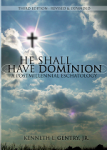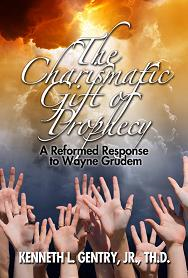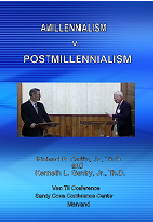PMW 2023-017 by Kenneth L. Gentry, Jr.
Recently a reader responded to one of my articles with a lengthy question. Rather than quickly answering it and moving on, I have decided to provide an answer in a full article. Perhaps later I will deal with it even more thoroughly in a series.
MY READER WROTE:
I’m not advocating for full preterism, but reading Mt. 24 and 1 Thess. 4-5 side-by-side (noted below) I can see a 1st century fulfillment in both places. To me, the only real clear passage that speaks to the end of time as we know it is, 1 Cor. 15:24.
Further, I am of the opinion that all of Mt. 24/25 was fulfilled in AD 70 as well, or is in the PROCESS of being fulfilled (an ONGOING reality). Further to the point, in Matthew 25, the bridegroom of the wise and foolish virgins returns to the same people he left. Similarly, the parable of the talents tells us the lord of the servants returned “after a long time” to the same people he left. “Now all these things happened to them as examples, and they were written for our admonition, upon whom the ends of the ages have come.” 1 Cor. 10:11.
Lastly, there are just too many similarities in Mt. 16:27-28; Mt. 25:31 and Rev 22:12 to think one might apply to AD 70 and another to the end of time, etc. The reference to Christ separating the sheep from the goats in Mt. 25:31 may be a typological fulfillment of Deut. 27:12 (blessing) and Deut. 27:13 (cursed). The separation of tribes unto Mt. Gerizim (blessed) and Mt. Ebal (cursed) took place towards the beginning of their entrance into the “physical” promised land (not the end). Christ separating sheep (blessed) and goats (cursed) could very well have started towards the beginning of the “spiritual” promised land. Christ, indeed, redeemed us from this curse, Gal. 3:13, and is therefore “gathering” the elect unto himself from the start of his reign until his last enemy is under foot. I.e., until the final judgment.
Thank you for allowing me to opine. I am simply a layman in the body of Christ trying to sort it all out. If I’m way off base, please feel free to correct me.
I greatly respect your work, Dr. Gentry. Blessings unto you.
More on Mt. 24 and 1 Thess. 4 (I read this elsewhere, but don’t recall the author to give proper credit.)
Matthew 24 – Fulfilled in AD 70 1 Thessalonians 4-5 Fulfilled in AD 70
1. Christ comes from heaven (24:30) 1. Christ comes from heaven (4:16)
2. With archangelic voice (24:31) 2. With archangelic voice (4:16)
3. With God’s trumpet call (24:31) 3. With God’s trumpet call (4:16)
4. Gathered/Caught to Christ (24:31) 4. Gathered/Caught to Christ (4:17)
5. Believers meet Christ in clouds (24:30) 5. Believers meet Christ in clouds (4:17)
6. Use of contemporary “you” and parousia to be fulfilled in their contemporary generation (24:34) 6. Use of contemporary “we” and parousia expected while some are still alive (4:15)
7. Exact time unknown (24:36) 7. Exact time unknown (5:1-2)
8. Christ comes like a thief (24:43) 8. Christ comes like a thief (5:2)
9. Unbelievers caught unaware (37-39) 9. Unbelievers caught unaware (5:3)
10. Birth pains (24:8 – fulfilled in AD 70) 10. Birth pains (5:3)
11. Believers are not deceived (24:43) 11. Believers are not deceived (5:4-5)
12. Believers told to be watchful (24:42) 12. Believers told to be watchful (5:6)
13. Exhortation against drunkenness (24:49) 13. Exhortation against drunkenness (5:7)
14. The Day, Sunlight (24:27, 36-38) 14. The Day, sons of light, sons of day

He Shall Have Dominion
(paperback by Kenneth Gentry)
A classic, thorough explanation and defense of postmillennialism (600+ pages). Complete with several chapters answering specific objections.
See more study materials at: www.KennethGentry.com
MY ME ANSWERED:
We must be careful when we lay Scriptures side-to-side in order to “connect the dots.” Scripture has a great repository of images that are re-useable in divergent situations.
For instance, we find several “day of the Lord” events in the OT that speak of different historical judgments (e.g., Isa. 24:21–22; Zeph. 1:14–18; Isa. 13:4–6, 9–11; Jer. 46:10; Eze. 30:3–4; Joel 3:12–14). In many respects they are similar in wording (lexicography) and in effect (divine judgment). Nevertheless they refer to different events. Similarity does not entail identity.
Perhaps the classic example of this interpretive concept is the two temple cleansings by Jesus. Though they look identical we know that one occurs at the beginning of his ministry (John 2:11; cp. vv. 13–22), while the other (Matt. 21:12–13) occurs at its end (Matt. 21:1–10). Thus, they are separated by over three years. This prophetic judgment sign was well placed at both the beginning and end of his ministry for theological reasons.
Again, it is so important that we understand that similarity does not entail identity. A failure to recognize this has led scores of people to adopt hyperpreterism by employing their “connect-the-dots” exegetical game. Just because two sets of images are similar does not mean they apply to the same historical event.
Furthermore, the AD 70 judgment was a part of a long line of “day of the Lord” events that pointed to a future, consummate day of the Lord, i.e., Christ’s second coming and the final judgment which end history, not just some earthly kingdom. The exact date of the coming of the Lord in final judgment is not known, but the actual fact of his coming at the end is well-prophesied in Scripture. A serious problem with the hyperpreterist’s theological system of an unending (i.e., un-renewed) world and continuing our current as-is history is that their worldview cannot explain God’s purpose for the world as a whole. Sad. In fact, effectively they do not have a “world” view.
Thine Is the Kingdom
(ed. by Ken Gentry)
Contributors lay the scriptural foundation for a biblically-based, hope-filled postmillennial eschatology, while showing what it means to be postmillennial in the real world.
See more study materials at: www.KennethGentry.com
In addition, orthodox preterists (and other interpretive schools!) recognize that the Olivet prophecy lies behind Paul’s imagery in 1 Thessalonians 4–5. This is because the two events to which they refer are related. They are related conceptually, not historically. One points beyond itself to the other: AD 70 is a distant adumbration of the Final Judgment.
Besides, several of the comparisons you make between 1 Thessalonians 4 and Matthew 24–25 are simply common, stock-in-trade images that can occur at any number of divine judgments: the archangel voice; unknown time; coming as a thief; birth pains; watchfulness; exhortation against drunkenness, and so forth.
I would argue that the first part of Olivet speaks of issues occurring in that generation (Matt. 24:34) in the first century (Matt. 24:4–34). The disciples were confused regarding Jesus’ prophecy of the temple’s destruction in v. 2, which leads to their wrong-headed supposition that the temple’s destruction entailed the end of the world (v. 3). This was due to three issues:
(1) Inter-testamental Judaism did not recognize that the Messiah was to suffer and die (as we see in the apocalyptic literature between 200 BC and AD 200). And (2) it held that when the Messiah came, he would overthrow the enemy. Thus, there was the anticipation “in the air,” as it were, that Jesus would do so (e.g., John 6:15). Consequently, the Jews, like John the Baptist (Matt. 11:2–3), were confused about what Jesus was doing — as they often were, especially regarding his death (Matt. 16:22) and resurrection (John 22:8–9). And furthermore, (3) first-century Jews believed that the temple would last to the end of history (see Philo, Spec. 1:76; Josephus, J.W. 5:11:2 §459; Sib. Or. 5:420–23).
MY ME CONCLUDING
So, in summary: 1 Thessalonians 4 looks like Matthew 24 for two basic reasons: (1) both are dealing with divine judgments that can employ the same stock-in-trade language; and (2) Paul uses the Olivet Discourse as his backdrop in pointing ahead to what Jesus was ultimately referring to: the final judgment (Matt. 25:31–46).
THE TWO AGES AND OLIVET
I am currently researching a study of the Two-Age structure of redemptive history. My starting point is based on the disciples’ questions to Jesus in Matthew 24:3. Much confusion reigns among those unacquainted over the Two-Age analysis of history that was promoted by Jesus and by Paul. The Two Ages are not the old covenant and the new covenant, but world history since the fall and the consummate order following the Second Coming and the Final Judgment.
If you would like to support me in my research, I invite you to consider giving a tax-deductible contribution to my research and writing ministry: GoodBirth Ministries. Your help is much appreciated!
Click on the following images for more information on these studies:
 |
 |
 |


Yes, similarity does not mean identity. I used to liken Matt. 24 to 1 Thes. 4 but no more. The latter is more like 1 Cor. 15. However, I still think Jesus does not shift to the far future until Matt. 25:31. The parables of the fig tree, faithful servant, ten virgins, and talents are time related. The fig tree is broader, with seasonal changes that can be readily seen, the others about the more specific day or hour, but I believe them to speak of the Temple, which is what Jesus said would be destroyed, which is why they asked their question, in the first place. I also believe that, in warning them to heed the signs in order to leave, He was telling them not to wait till the last minute. For Jesus to spend the more significant part about the end seems out of place. JMHO.
I will answer your concerns in a future article showing your confusion on the issues. Keep watching!
I will answer your confusions in an article to be published on April 21. Stay tuned.
Thank you, Dr. Gentry. Very insightful commentary. There’s a lot to digest here as it relates to similarities between Mt. 24 and 1 Thess. 4/5: I.e, “They are related conceptually, not historically. One points beyond itself to the other.” I do believe in a physical resurrection when Christ comes again to end all things (1 Cor. 15), but I still struggle with the gathering (1 Thess 4:16-17- Mt. 24:31) and the “contextually connected” day of the Lord (1 Thess. 5:2) being a future event. The gathering unto Christ (spiritually) seems to be tied to when the man of sin was revealed (persecution under nero). We read this in 2 Thess. 2:1-4 However, like the faithful Berean, I will continue to go to the scriptures and work this out with the help of the Holy Spirit. Thank you for taking the time to further explain your position. God Bless.
Keep studying!
[…] Dr. Gentry wrote elsewhere, […]